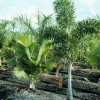 Field production is the most practical means of producing large palm specimens, and it has several advantages over container production. Yield per acre can be maximized compared to many other woody ornamentals because of the columnar growth habit of most palms and their ability to survive transplanting with a minimal root ball. When dug and tied properly, many more palms can be loaded into a standard shipping container than could similarly sized trees. Palms also offer great versatility in the method of field harvesting.This 7-page fact sheet was written by Timothy K. Broschat, Alan W. Meerow, and Jack Miller, and published by the UF Department of Environmental Horticulture, April 2013.
Field production is the most practical means of producing large palm specimens, and it has several advantages over container production. Yield per acre can be maximized compared to many other woody ornamentals because of the columnar growth habit of most palms and their ability to survive transplanting with a minimal root ball. When dug and tied properly, many more palms can be loaded into a standard shipping container than could similarly sized trees. Palms also offer great versatility in the method of field harvesting.This 7-page fact sheet was written by Timothy K. Broschat, Alan W. Meerow, and Jack Miller, and published by the UF Department of Environmental Horticulture, April 2013.
http://edis.ifas.ufl.edu/ep471
Tag: A. W. Meerow
Royal Palm Bug, Xylastodoris luteolus Barber (Insecta: Hemiptera: Thaumastocoridae) (EENY097/IN254)
This insect species is one of the few arthropods that feed on Cuban royal palms which are native to Florida and Cuba, and is the only representative of the small tropical family of Thaumastocoridae in North America. This revised 3-page fact sheet was written by T. J. Weissling, F. W. Howard, and A. W. Meerow, and published by the UF Department of Entomology and Nematology, January 2011.
http://edis.ifas.ufl.edu/in254